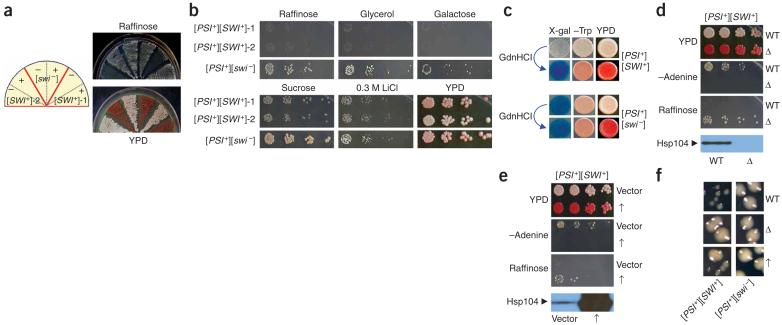Figure 2.
Isolation and characterization of [SWI+] candidates. (a) [SWI+]-1 and [SWI+]-2, two [SWI+] candidates isolated from [PSI+] cells upon co-overexpression of SUP35NMGFP and SWI1, showed a guanidine hydrochloride-curable Raf- phenotype. Shown are cell streaks of the candidates before (-) and after (+) guanidine hydrochloride (GdnHCl) treatment on indicated media. Note that both of the plasmids, pRS313CUP1NMGFP and p426GPD-SWI1, were eliminated before 5 mM guanidine hydrochloride treatment. (b) Phenotypic assays of the [PSI+][SWI+] candidates. [SWI+] candidates and [SWI-] control were grown in YPD to mid-log phase and then spotted to the indicated media with a fivefold serial dilution. (c) [SWI+]-2 (upper) and [SWI-] (lower) cells containing pLS7 plasmid (Trp+), a SWI/SNF lacZ reporter controlled by a chimeric promoter composed of the SWI/SNF regulatory sequence of SUC2 promoter and the core promoter of LEU2 (ref. 24), were spotted onto +sucrose -tryptophan synthetic complete media + 20 μg/ml X-gal plates (X-gal); +glucose -tryptophan synthetic complete medium plates (-Trp); and YPD (YPD) plates. (d) HSP104 deletion eliminated [PSI+] and the Raf- phenotype. [SWI+]-2 cells with (Δ) or without (WT) HSP104 disruption were assayed on indicated media. (e) The effect of HSP104 overexpression on Raf- phenotype. [SWI+]-2 cells containing p2HGHSP104 (↑) or p2HG (vector) were grown in synthetic complete liquid media lacking histidine and then spotted to the indicated media. HSP104 disruption and overexpression were confirmed by immunoblot analysis using a polyclonal Hsp104 antibody. (f) Enlarged images showing the colony sizes of [PSI+][SWI+] and [PSI+][SWI-] cells after HSP104 deletion (Δ), overexpression (↑) or no treatment (WT). A [PSI+] isolate with Raf+ phenotype obtained under identical conditions for [SWI+] candidate isolation was used as the nonprion ([SWI-]) control in all experiments described in this figure.

